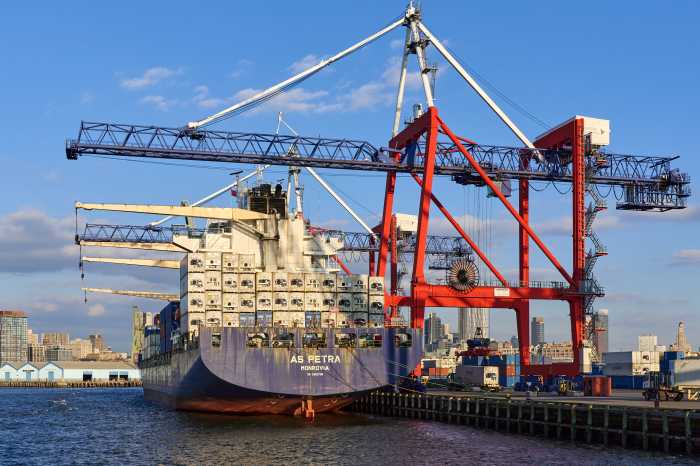By Elizabeth O’Brien
A beach at the base of the Brooklyn Bridge, 1,000 river birch trees along the esplanade, recreation and retail under the F.D.R. Drive. These are among the possibilities for a revitalized East River waterfront that the city presented to the community this week.
At a June 21 meeting of Community Board 1, the city outlined a vision for the East River waterfront that would transform today’s inaccessible, trash-strewn stretch of land into a recreational paradise worthy of the prime real estate that it occupies. The study area extends from the tip of Lower Manhattan to Montgomery St. on the Lower East Side, where the East River Park ends.
“This could be an incredible gift for future generations,” said Gregg Pasquarelli, an architect with Manhattan-based SHoP Architects, one of several firms the city commissioned to submit designs for the waterfront. Richard Rogers Partnership, the celebrated British architectural firm, created Monday’s presentation with SHoP.
Officials stressed their design was an initial rendering and asked for community input to help it progress. Funding for the project has not been established yet, and it remains unclear how many of the proposed design elements will actually come to pass. Daniel Doctoroff, deputy mayor for economic development and rebuilding, has sought money from the Lower Manhattan Development Corp. to fund improvements for the East River waterfront.
Short-term goals of waterfront revitalization included improving access to the river, completing the circle of green ringing Manhattan, and creating a waterfront environment that would sustain growth over time. Monday’s presentation focused on land designs that could be accomplished within three to five years. Future presentations will tackle the more complex and heavily regulated maritime aspects, officials said.
Chain link fences cut people off from the river along at least 14 acres of waterfront, presenters said, and removing the fences and concrete jersey barriers would represent one of the easiest improvements under consideration. The plan would also focus on creating direct access to the waterfront from places like the Vietnam Veterans Memorial at Coenties Slip, possibly by a new pedestrian bridge. Another new pedestrian bridge was proposed to link the renovated Whitehall Ferry terminal to the esplanade.
City planning officials said the Community Board 1-Downtown Alliance waterfront study served as a valuable reference for the designs presented on Monday. Completed in 2002 by the firm Skidmore, Owings & Merrill, the C.B. 1 plan was an “incredibly well-done study,” Amanda Burden, chairperson of City Planning, said at the meeting. Like the city design, it featured a pedestrian walkway under the F.D.R., with shops and cafes.
“I don’t have to tell anyone here that the East River waterfront is one of the most important elements in the revitalization of Lower Manhattan,” Burden said.
Community board members said they appreciated that the city was finally turning its attention to the East Side.
“First of all, I’m ecstatic we’re talking about the East Side waterfront,” said John Fratta, a board member and Southbridge Towers resident. Fratta said he would prefer to see more maritime uses proposed for the Seaport area.
Many sounded a note of concern that the spruced up waterfront would turn into a tourist trap. One plan under consideration for Pier 14 near the South Street Seaport includes a large Ferris wheel by the London firm Tussauds Group, of celebrity wax-figure museum fame.
“It’s something we’re keeping an open mind to, but nothing has been decided yet,” said Robert Balder, the director of Lower Manhattan development for the mayor’s office.
“We do not want it in our community,” said Linda Roche, chairperson of the C.B. 1 waterfront committee.
Some offered practical suggestions about what they would like to see in the area instead. Clara Lipson, a long-time Seaport resident, said she would welcome a Whole Foods-type market.
“It’s a highly residential area and there’s really no place to shop,” Lipson said.
Community members have suggested that Whole Foods would make a good addition to the Seaport after the Fulton Fish Market leaves for the Bronx around the end of this year. The Rouse Company, operator of the Seaport retail, has right of first refusal on the Tin Building and the Fulton Market Stalls, two buildings now occupied by the market.
Michael Piazzola, general manager of the Seaport Marketplace, has said a problem with Whole Foods was that the popular chain required 39,000 square feet and there were few spaces of that size within the Seaport.
Balder was mum on what might be in store for the Seaport once the fish market leaves, saying only that the city had been in discussions with the Rouse Company.
The plan for the East River waterfront will be finalized in about eight months, city officials said. None of the plans proposed would block the surrounding area’s water view, the architects said.
Instead, Pasquarelli said, the design would revive a neglected part of the city: “Why not bring the of life in New York right to the edge?”
WWW Downtown Express

































